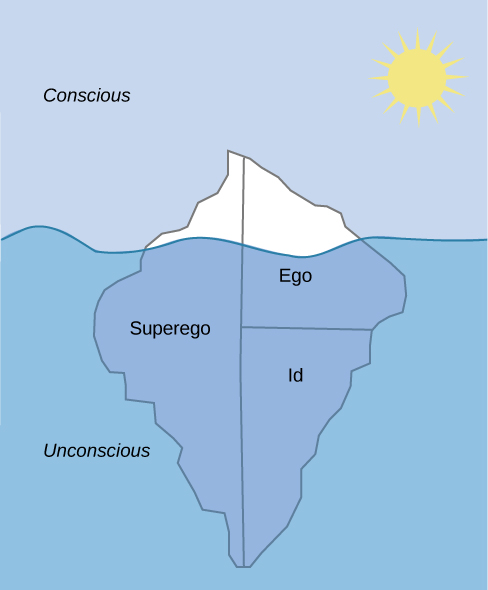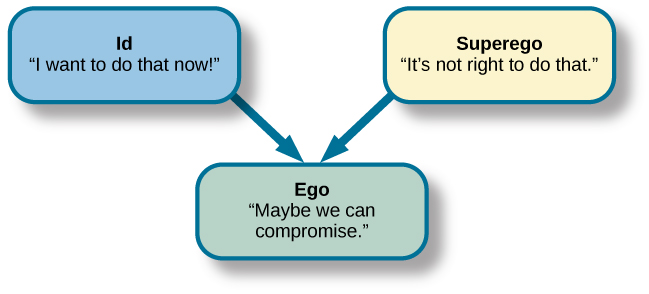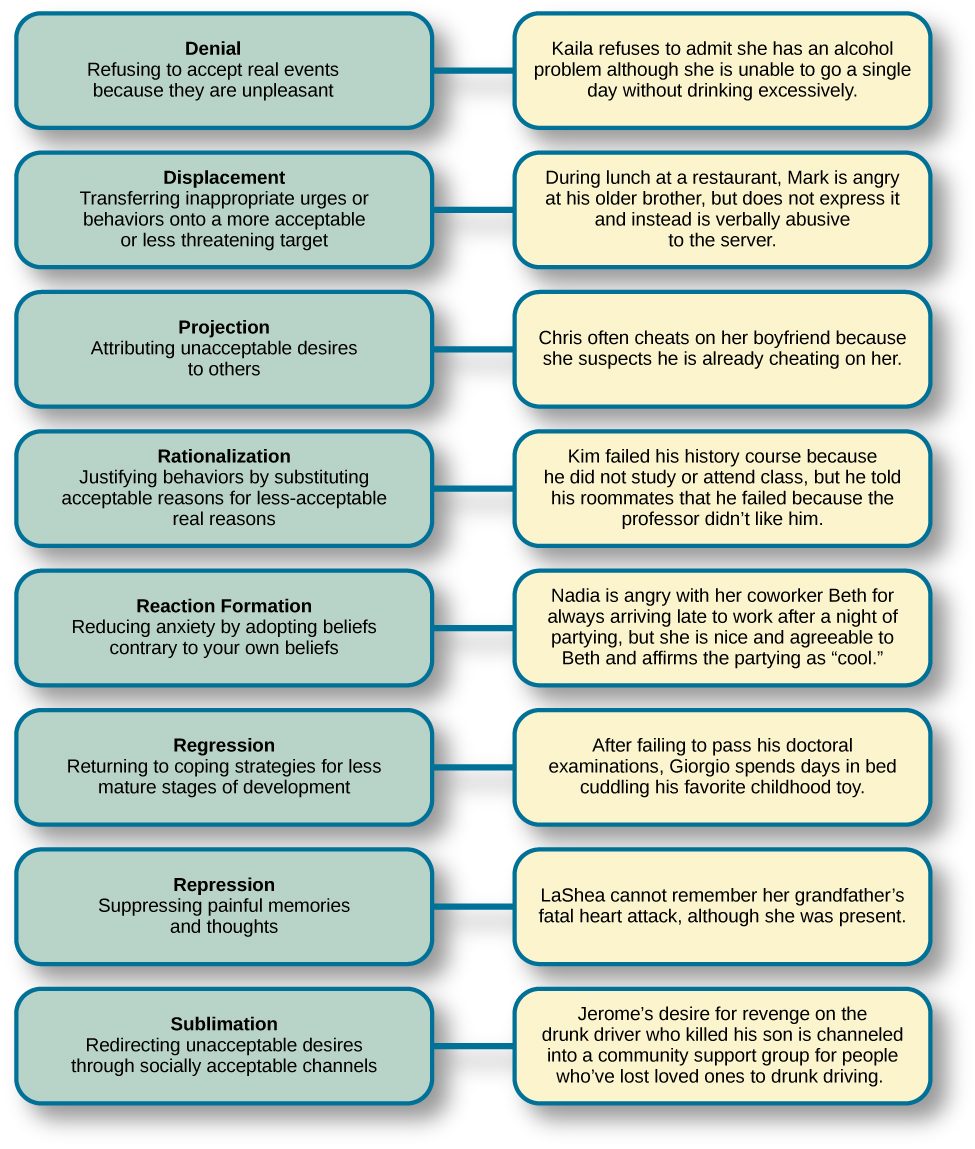98 Freud and the Psychoanalytic Perspective
Learning Objectives
By the end of this section, you will be able to:
- Describe the assumptions of the psychoanalytic perspective on personality development
- Define and describe the nature and function of the id, ego, and superego
- Define and describe the defence mechanisms
Sigmund Freud (1856–1939) is probably the most controversial and misunderstood psychological theorist. When reading Freud’s theories, it is important to remember that he was a medical doctor, not a psychologist. There was no such thing as a degree in psychology at the time that he received his education, which can help us understand some of the controversy over his theories today. However, Freud was the first to systematically study and theorize the workings of the unconscious mind in the manner that we associate with modern psychology.
In the early years of his career, Freud worked with Josef Breuer, a Viennese physician. During this time, Freud became intrigued by the story of one of Breuer’s patients, Bertha Pappenheim, who was referred to by the pseudonym Anna O. (Launer, 2005). Anna O. had been caring for her dying father when she began to experience symptoms such as partial paralysis, headaches, blurred vision, amnesia, and hallucinations (Launer, 2005). In Freud’s day, these symptoms were commonly referred to as hysteria. Anna O. turned to Breuer for help. He spent 2 years (1880–1882) treating Anna O. and discovered that allowing her to talk about her experiences seemed to bring some relief of her symptoms. Anna O. called his treatment the “talking cure” (Launer, 2005). Despite the fact the Freud never met Anna O., her story served as the basis for the 1895 book, Studies on Hysteria, which he co-authored with Breuer. Based on Breuer’s description of Anna O.’s treatment, Freud concluded that hysteria was the result of sexual abuse in childhood and that these traumatic experiences had been hidden from consciousness. Breuer disagreed with Freud, which soon ended their work together. However, Freud continued to work to refine talk therapy and build his theory on personality.
TRICKY TOPIC: FREUD’S THEORY OF PERSONALITY
If the video above does not load, click here: https://youtu.be/qWY-JQ7etKo
Levels of Consciousness
To explain the concept of conscious versus unconscious experience, Freud compared the mind to an iceberg (Figure P.5). He said that only about one-tenth of our mind is conscious, and the rest of our mind isunconscious. Our unconscious refers to that mental activity of which we are unaware and are unable to access (Freud, 1923). According to Freud, unacceptable urges and desires are kept in our unconscious through a process called repression. For example, we sometimes say things that we don’t intend to say by unintentionally substituting another word for the one we meant. You’ve probably heard of a Freudian slip, the term used to describe this. Freud suggested that slips of the tongue are actually sexual or aggressive urges, accidentally slipping out of our unconscious. Speech errors such as this are quite common. Seeing them as a reflection of unconscious desires, linguists today have found that slips of the tongue tend to occur when we are tired, nervous, or not at our optimal level of cognitive functioning (Motley, 2002).


The id and superego are in constant conflict, because the id wants instant gratification regardless of the consequences, but the superego tells us that we must behave in socially acceptable ways. Thus, the ego’s job is to find the middle ground. It helps satisfy the id’s desires in a rational way that will not lead us to feelings of guilt. According to Freud, a person who has a strong ego, which can balance the demands of the id and the superego, has a healthy personality. Freud maintained that imbalances in the system can lead to neurosis (a tendency to experience negative emotions), anxiety disorders, or unhealthy behaviours. For example, a person who is dominated by their id might be narcissistic and impulsive. A person with a dominant superego might be controlled by feelings of guilt and deny themselves even socially acceptable pleasures; conversely, if the superego is weak or absent, a person might become a psychopath. An overly dominant superego might be seen in an over-controlled individual whose rational grasp on reality is so strong that they are unaware of their emotional needs, or, in a neurotic who is overly defensive (overusing ego defence mechanisms).
Defence Mechanisms
Freud believed that feelings of anxiety result from the ego’s inability to mediate the conflict between the id and superego. When this happens, Freud believed that the ego seeks to restore balance through various protective measures known as defence mechanisms (Figure P.7). When certain events, feelings, or yearnings cause an individual anxiety, the individual wishes to reduce that anxiety. To do that, the individual’s unconscious mind uses ego defence mechanisms, unconscious protective behaviours that aim to reduce anxiety. The ego, usually conscious, resorts to unconscious strivings to protect the ego from being overwhelmed by anxiety. When we use defence mechanisms, we are unaware that we are using them. Further, they operate in various ways that distort reality. According to Freud, we all use ego defence mechanisms.

There are several different types of defence mechanisms. For instance, in repression, anxiety-causing memories from consciousness are blocked. As an analogy, let’s say your car is making a strange noise, but because you do not have the money to get it fixed, you just turn up the radio so that you no longer hear the strange noise. Eventually you forget about it. Similarly, in the human psyche, if a memory is too overwhelming to deal with, it might be repressed and thus removed from conscious awareness (Freud, 1920). This repressed memory might cause symptoms in other areas.
Another defence mechanism is reaction formation, in which someone expresses feelings, thoughts, and behaviours opposite to their inclinations. In the above example, Joe made fun of a gay peer while himself being attracted to males. In regression, an individual acts much younger than their age. For example, a four-year-old child who resents the arrival of a newborn sibling may act like a baby and revert to drinking out of a bottle. In projection, a person refuses to acknowledge her own unconscious feelings and instead sees those feelings in someone else. Other defence mechanisms include rationalization, displacement, and sublimation.

